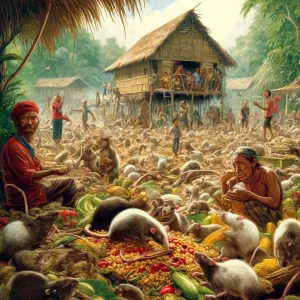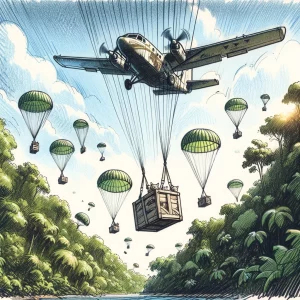Operation Cat Drop 1959: The Strangest Airdrop in History
 Picture seeing parachutes descending from the sky, but instead of soldiers or supplies, they carried cats! This might sound like a scene from a whimsical movie, but it actually happened in the jungles of Borneo in 1959.
Picture seeing parachutes descending from the sky, but instead of soldiers or supplies, they carried cats! This might sound like a scene from a whimsical movie, but it actually happened in the jungles of Borneo in 1959.
Operation Cat Drop was a peculiar yet fascinating event where cats were dropped from airplanes to solve an unexpected ecological problem. What led to this unusual mission, and what were its outcomes? This blog post will unravel the story behind Operation Cat Drop and its impact on the people of Borneo.
The Health Crisis in Borneo
In the 1950s, the World Health Organization (WHO) initiated a campaign to eradicate malaria in Borneo. Malaria,  spread by mosquitoes, was a major health issue for the Dayak people living in the remote jungles. The WHO decided to use DDT, a powerful insecticide, to kill the mosquitoes and control the disease. Insecticides are chemicals used to kill insects and are often employed in agriculture and public health to control pests. While this approach was initially successful, it triggered a series of unintended ecological consequences.
spread by mosquitoes, was a major health issue for the Dayak people living in the remote jungles. The WHO decided to use DDT, a powerful insecticide, to kill the mosquitoes and control the disease. Insecticides are chemicals used to kill insects and are often employed in agriculture and public health to control pests. While this approach was initially successful, it triggered a series of unintended ecological consequences.
The use of DDT led to a significant reduction in mosquito populations, which in turn decreased malaria cases. However, DDT did not discriminate between harmful and beneficial insects. This mass extermination caused a rise in caterpillar populations as their natural predators were eliminated. The caterpillars began to ravage local crops, creating a new problem for the Dayak people. Moreover, the poison traveled up the food chain, affecting other insect-eating species such as lizards and birds, and eventually, the local cats.
Unintended Consequences
 As the local cats ingested the poisoned insects, their population dwindled significantly. With fewer cats around to control them, the rat population exploded. Rats, being prolific breeders, quickly became a major problem, destroying crops and spreading diseases such as sylvatic plague and typhus, which posed new health risks to the Dayak people.
As the local cats ingested the poisoned insects, their population dwindled significantly. With fewer cats around to control them, the rat population exploded. Rats, being prolific breeders, quickly became a major problem, destroying crops and spreading diseases such as sylvatic plague and typhus, which posed new health risks to the Dayak people.
This ecological imbalance highlighted the complexities and potential pitfalls of using chemicals like DDT in large-scale public health campaigns. The initial solution to one problem inadvertently caused another, more serious issue.
Did You Know?
Did you know that the collapse of the predator-prey balance due to DDT not only affected cats and rats but also led to an overpopulation of caterpillars, which caused significant damage to the local crops and food supply for the Dayak people?
Operation Cat Drop Solution
The WHO devised a unique solution to address the growing rat problem: airdropping cats into the affected areas.  Parachutes were attached to crates carrying cats, which were then dropped from airplanes into the jungles of Borneo. This strange yet effective strategy aimed to replenish the cat population and help control the rampant rat problem.
Parachutes were attached to crates carrying cats, which were then dropped from airplanes into the jungles of Borneo. This strange yet effective strategy aimed to replenish the cat population and help control the rampant rat problem.
The planning and execution of Operation Cat Drop were meticulously handled to ensure the safety of the cats. The parachutes were designed to allow a gentle descent, and the crates protected the cats during their fall. Once on the ground, the cats quickly adapted to their new environment and began to hunt the rats.
The operation proved successful as the increased number of cats helped to reduce the rat population, thereby mitigating the health risks and crop destruction caused by the rodents. This restored a degree of ecological balance and showcased an innovative solution to an unusual problem.
Operation Cat Drop remains one of the most unusual yet fascinating events in modern history. It highlights the complexities of ecological interventions and the unexpected consequences that can arise from well-intentioned actions. As one Dayak villager reportedly said, “It rained cats and saved our crops!”
Find Out More!
– Website: The Unintended Consequences of DDT Use in Borneo – a comprehensive article on the ecological impact of DDT.
– Book: Silent Spring by Rachel Carson – a groundbreaking book on the environmental effects of pesticides.
0 Comments